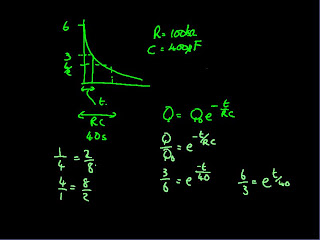This is not in order. You will have to print them and put the jigsaw puzzle together.
These are exports from the interactive whiteboard notes made during the lesson. No attempt has been made to edit them. Not all lessons will be published. If you print these you will use a lot of ink!
Wednesday, December 19, 2012
Thursday, December 13, 2012
Wednesday, December 05, 2012
Wednesday, November 21, 2012
Tuesday, November 20, 2012
Y12 a bouncing ball
The papers I marked were not good on this. Here are some notes I gave to the GCSE students. THey may be of use.
http://twyfordigcsephysics.blogspot.co.uk/2012/11/bouncing-ball-in-slow-mo.html
http://twyfordigcsephysics.blogspot.co.uk/2012/11/bouncing-ball-in-slow-mo.html
Monday, November 12, 2012
Tuesday, October 09, 2012
Y12 F= ma results
Force
N
|
Acceleration
(ms-2)
|
1
|
1.3
|
2
|
1.6
|
3
|
1.9
|
4
|
2.4
|
5
|
2.58
|
Number
of Weights
|
Acceleration
A to B ms-2
|
0
|
1.11
|
1
|
0.66
|
2
|
0.47
|
3
|
0.34
|
4
|
0.28
|
5
|
0.22
|
6
|
Monday, October 08, 2012
Friday, September 21, 2012
SHM Calculations
1 The motion
of a mass m is represented by the following expressions, where x is the
displacement from a fixed point and k and a are positive constants. Which of
these expressions represent simple harmonic motion?
A acceleration = kx, B velocity = kx, C acceleration = -kx
D velocity = -k(x2 - a2), E
velocity = k(a2 x) A acceleration = kx, B velocity = kx, C acceleration = -kx
2 A mass of 0.01 kg is vibrating up and down with simple harmonic motion; its amplitude is 40mm, and the period is 2s. Find (i) the velocity and acceleration at the centre of oscillation, (ii) its acceleration 10mm from the centre, (iii) its kinetic energy at the centre. At what point is the potential energy a maximum?
3 In simple harmonic motion, a mass of 0.1kg has an amplitude of 10 mm. Calculate (i) the maximum velocity and (ii) the maximum force on the mass, if the period of the motion is p /2 s.
4 A vibrating mass of 0.06 kg has an amplitude of 0.08 m and a period of 4s. Find the velocity, acceleration and kinetic energy at the middle of the motion. What is the maximum value of the kinetic energy during the motion?
5 Draw sketches of the variations of (i) the kinetic energy, (ii) the potential energy, (iii) the total energy of a particle during one cycle of s.h.m. Account for the appearance of the graphs.
Wednesday, September 12, 2012
Wednesday, May 16, 2012
Subscribe to:
Comments (Atom)


















































